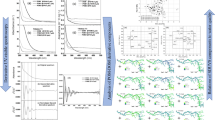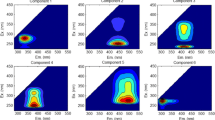Abstract
UV-visible spectroscopy and synchronous fluorescence spectroscopy (SFS) combined with two-dimensional correlation spectroscopy (2D-COS) were applied for extracting fluorescence components, tracing organic functional groups, and revealing variations of dissolved organic matter (DOM) in Puhe River. Water samples were collected from the mainstream and two tributaries (Nanxiaohe River and Huangnihe River). DOM in three rivers was composed of protein-like fluorescent (PLF), microbial humus-like fluorescent (MHLF), fulvic-like fluorescent (FLF), and humic-like fluorescent components, which were relative to aromatic groups, phenolic groups, carboxylic groups, and microbial products. The PLF and MHLF were dominated in DOM fractions in the rivers, and the average content of the PLF was the highest in Nanxiaohe River. Humification degree of DOM was the highest in Puhe River, followed by Huangnihe River and Nanxiaohe River. However, molecular mass of DOM in Puhe River was the lowest, followed by Huangnihe River and Nanxiaohe River. Based on the 2D-COS of the SFS and UV-visible spectra, the variation order of DOM fractions in Puhe River was PLF → MHLF → FLF, and the PLF was consistent with the phenolic groups, aromatic groups, and carboxylic groups, but the adverse trend with the microbial products. The variation order in Nanxiaohe River was MHLF → PLF → FLF, and the MHLF was consistent with the aromatic groups, phenolic groups, carboxylic groups, and microbial products. The variation order in Huangnihe River was MHLF → PLF → FLF too, and the PLF was consistent with the carboxylic groups and aromatic groups. The results of the present study demonstrate that UV-visible spectroscopy and SFS combined with 2D-COS are useful methods to characterize structural composition of DOM from urban black and stinky rivers so as to investigate their pollution status.









Similar content being viewed by others
Data availability
The datasets obtained and analyzed in the research can be available from the first author on reasonable request.
References
Abdelal A, El-Enany N, Belal F (2009) Simultaneous determination of sulpiride and its alkaline degradation product by second derivative synchronous fluorescence spectroscopy. Talanta 80(2):880–888
Albrecht R, Petit J, Gérard T (2011) Comparison between UV spectroscopy and nirs to assess humification process during sewage sludge and green wastes co-composting. Bioresour Technol 102:4495–4500
Al-Reasi HA, Wood CM, Smith DS (2013) Characterization of freshwater natural dissolved organic matter (DOM): mechanistic explanations for protective effects against metal toxicity and direct effects on organisms. Environ Int 59:201–207
Baduel C, Voisin D, Jaffrezo J (2009) Comparison of analytical methods for HULIS measurements in atmospheric particles. Atmos Chem Phys 9:5949–5962
Baker A (2002a) Fluorescence properties of some farm wastes: implications for water quality monitoring. Water Res 36(1):189–195
Baker A (2002b) Fluorescence excitation-emission matrix characterization of river waters impacted by a tissue mill effluent. Environ Sci Technol 36(7):1377–1382
Chen J, Gu B, Leboeuf E, Pan H, Dai S (2002) Spectroscopic characterization of the structural and functional properties of natural organic matter fractions. Chemosphere 48:59–68
Dave HN, Mashru RC, Thakkar AR (2007) Simultaneous determination of salbutamol sulphate, bromhexine hydrochloride and etofylline in pharmaceutical formulations with the use of four rapid derivative spectrophotometric methods. Anal Chim Acta 597:113–120
Guo X, Yuan D, Jiang J (2013) Detection of dissolved organic matter in saline–alkali soils using synchronous fluorescence spectroscopy and principal component analysis. Spectrochim Acta A Mol Biomol Spectrosc 104:280–286
Habibul N, Chen W (2018) Structural response of humic acid upon binding with lead: a spectroscopic insight. Sci Total Environ 643:479–485
He X, Xi B, Wei Z et al (2011) Spectroscopic characterization of water extractable organic matter during composting of municipal solid waste. Chemosphere 82(4):541–548
He W, Lee J, Hur J (2016) Anthropogenic signature of sediment organic matter probed by UV-Visible and fluorescence spectroscopy and the association with heavy metal enrichment. Chemosphere 150:184–193
Hudson N, Baker A, Ward D, Reynolds DM, Brunsdon C, Carliellmarquet C, Browning S (2008) Can fluorescence spectrometry be used as a surrogate for the Biochemical Oxygen Demand (BOD) test in water quality assessment? An example from South West England. Sci Total Environ 391:149–158
Hur J, Jung K, Jung Y (2011) Characterization of spectral responses of humic substances upon UV irradiation using two-dimensional correlation spectroscopy. Water Res 45:2965–2974
Kalbitz K, Geyer W, Geyer S (1999) Spectroscopic properties of dissolved humic substances a reflection of land use history in a fen area. Biogeochemistry 47:219–238
Kida M, Kojima T, Tanabe Y, Hayashi K, Kudoh S, Maie N, Fujitake N (2019) Origin, distributions, and environmental significance of ubiquitous humic-like fluorophores in Antarctic lakes and streams. Water Res 163:114901
Landry C, Tremblay L (2012) Compositional differences between size classes of dissolved organic matter from freshwater and seawater revealed by an HPLC-FTIR system. Environ Sci Technol 46:1700–1707
Leenheer J (2003) Characterizing aquatic dissolved organic matter. Environ Sci Technol 37:18A–26A
Li M, He X, Liu J (2010) Ultraviolet absorption spectra of watersoluble organic compounds from chicken manure compost. Spectrosc Spectr Anal 30:3081–3085
Li L, Jiang T, Lu S (2014) Using ultraviolet-visible (UV-Vis) absorption spectrum to estimate the dissolved organic matter (DOM) concentration in water, soils and sediments of typical water-level fluctuation zones of the Three Gorges Reservoir areas. Environ Sci 35:3408
Mistry B (2009) A handbook of spectroscopic data chemistry: UV, IR, PMR, CNMR and mass spectroscopy. Oxford Book Co., New Delhi
Noda I, Ozaki Y (eds) (2004) Two-dimensional correlation spectroscopy—applications in vibrational and optical spectroscopy. John Wiley and Sons, Chichester
Noda I, Ozaki Y, Chester W (2004) Two-dimensional correlation spectroscopy—applications in vibrational and optical spectroscopy. Sci China Chem 47:257–266
Ogura N, Hanya T (1966) Nature of ultra-violet absorption of sea water. Nature 212:758–758
Page D, Leeuwen J, Spark K (2001) Tracing terrestrial compounds leaching from two reservoir catchments as input to dissolved organic matter. Mar Freshw Res 52:223–233
Pan H, Yu H, Song Y, Liu R, Du E (2017) Application of solid surface fluorescence EEM spectroscopy fortracking organic matter quality of native halophyte and furrow-irrigated soils. Ecol Indic 73:88–95
Pan H, Yu H, Wang Y, Liu R, Lei H (2018) Investigating variations of fluorescent dissolved organic matter in wastewater treatment using synchronous fluorescence spectroscopy combined with principal component analysis and two-dimensional correlation. Environ Technol 39:2495–2502
Qian F, Wu JY, Yu HB, Song YH, Zhang M, Kong LH, He MC (2016) UV-visible spectra properties of DOM from Taizi River in Benxi City section by multivariable analysis. Huan Jing Ke Xue 37(10):3806–3812
Salma I, Ocskay R, Láng G (2008) Properties of atmospheric humic-like substances water system. Atmos Chem Phys 8:2243–2254
State Environment Protection Administration of China (SEPA) (2002) Methods for water and wastewater monitoring and analysis in China, 4th edn. China Environmental Science Press, Beijing
Stromberg M (2013) Verde, Vivible, y Valorizado’. Planning 79:49–49
Tian L, Hu J, Li C (2010) Evaluation of a typical plateau deep lake by DOM spectral characteristics. Eng Sci 12:79–80
Wang X, Zheng B, Liu L (2012) Correlation analysis of macroinvertebrate composition and environmental factors of typical sections in Dongting Lake. Environ Sci China 32:2237–2244
Xu MD, Zheng J, Lu JJ, Zhang ZJ (2012) Extension method of black-odor of the urban river. Adv Mater Res 1793:2514–2517
Xu J, Tan W, Xiong J (2016) Copper binding to soil fulvic and humic acids: NICA-Donnan modeling and conditional affinity spectra. J Colloid Interface Sci 473:141–151
Xu P, Zhu J, Fu Q (2018) Structure and biodegradability of dissolved organic matter from Ultisol treated with long-term fertilizations. J Soil Sediment 18(5):1865–1872
Yan M, Korshin G, Wang D (2012) Characterization of dissolved organic matter using high-performance liquid chromatography (HPLC)–size exclusion chromatography (SEC) with a multiple wavelength absorbance detector. Chemosphere 87:879–885
Yu G, Tang Z, Xu Y (2011a) Multiple fluorescence labeling and two dimensional FTIR–13C NMR heterospectral correlation spectroscopy to characterize extracellular polymeric substances in biofilms produced during composting. Environ Sci Technol 45:9224–9231
Yu H, Xi B, Ma W (2011b) Fluorescence spectroscopic properties of dissolved fulvic acids from salined flavo-aquic soils around Wuliangsuhai in Hetao Irrigation District, China. Soil Sci Soc Am J 75:1385
Yu H, Song Y, Tu X (2013) Assessing removal efficiency of dissolved organic matter in wastewater treatment using fluorescence excitation emission matrices with parallel factor analysis and second derivative synchronous fluorescence. Bioresour Technol 144:595–601
Yu H, Song Y, Pan H, Peng J, Gao H, Liu R (2016) Synchronous fluorescence spectroscopy combined with two-dimensional correlation and principle component analysis to characterize dissolved organic matter in an urban river. Environ Monit Assess 188:579–579
Zbytniewski R, Buszewski B (2005) Characterization of natural organic matter (NOM) derived from sewage sludge compost. Part 1: chemical and spectroscopic properties. Bioresour Technol 96(4):471–478
Zhu Y, Song Y, Yu H, Liu R, Liu L, Lv C (2017) Characterization of dissolved organic matter in Dongjianghu Lake by UV-visible absorption spectroscopy with multivariate analysis. Environ Monit Assess 189:443–452
Acknowledgments
We would like to express our sincere thanks to the anonymous reviewers. Their insightful comments were helpful for improving the manuscript.
Funding
This work was financially supported by the National Major Program of Science and Technology for Water Pollution Control and Governance (fund number, 2018ZX07111-001, People’s Republic of China) and China Postdoctoral Science Foundation (fund number, 2013T60148).
Author information
Authors and Affiliations
Contributions
D.L. and H.Y. carried out the experiments, analyzed the data, and wrote the manuscript; H.G. and H.F. analyzed the data and modified the manuscript; H.Y. and G.Z. wrote the manuscript and improved the language of the manuscript. All authors have read and agreed to the published version of the manuscript.
Corresponding authors
Ethics declarations
Competing interests
The authors declare that they have no competing interests.
Ethics approval and consent to participate
Not applicable.
Consent for publication
Not applicable.
Additional information
Responsible Editor: Philippe Garrigues
Publisher’s note
Springer Nature remains neutral with regard to jurisdictional claims in published maps and institutional affiliations.
Rights and permissions
About this article
Cite this article
Liu, D., Yu, H., Gao, H. et al. Applying synchronous fluorescence and UV-vis spectra combined with two-dimensional correlation to characterize structural composition of DOM from urban black and stinky rivers. Environ Sci Pollut Res 28, 19400–19411 (2021). https://doi.org/10.1007/s11356-020-12168-y
Received:
Accepted:
Published:
Issue Date:
DOI: https://doi.org/10.1007/s11356-020-12168-y




